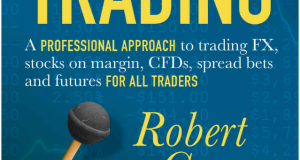 Back in 2014 I wrote some articles on the subject of technical analysis and the CMT Association, previously known as the MTA. I spoke my mind in the belief that quite few people would read it and even fewer would care. I had no idea that these articles would get quite a wide circulation and cause a bit more commotion than I had intended.
Back in 2014 I wrote some articles on the subject of technical analysis and the CMT Association, previously known as the MTA. I spoke my mind in the belief that quite few people would read it and even fewer would care. I had no idea that these articles would get quite a wide circulation and cause a bit more commotion than I had intended.
My first book, Following the Trend, had just been published a few months earlier. As the book had unexpected success, a fairly large audience started coming to my little website. To date, that article criticizing technical analysis has been read over 220,000 times.
In the first article, I pointed out that the term Technical Analysis has a somewhat poor reputation among market professionals. I made the case that the inclusion and acceptance of ridiculous nonsense like magical waves and fate determining numerology as well as the large number of get-rich-quick scams in the field means that the part of TA that does make sense gets overlooked and ignored.
Having started out with classical technical analysis back in the early 90’s, I had gotten increasingly frustrated with pseudo religious woo and outright scams that went unchallenged in the field. I tried to make the case that it is the responsibility of the technical analysis organizations to address this issue or face irrelevancy.
My article upset some and was welcomed by others. I had the usual mix of praise, insults and the odd threat of violence. One of the feedback letters made an interesting point. He asked why I am apparently still a member of the CMT Association. Fair point, I thought, and wrote a new article about my reasons for leaving.
That article addressed the CMT certification, something that I myself had completed many years earlier. While there was some great books and topics included, the curriculum also included the usual magic. Waves, numerology, astrology and things that serve no other purpose but to sell unverifiable analysis reports.
Some time afterwards, I came to understand that my article had been the subject of some debate inside the CMT association itself. As it turns out, there already was a debate on the topic and my article probably threw some additional gasoline on that particular fire.
After being contacted by the organization, I agreed to stop picking on them. Mostly because I really didn’t have any intention of doing so anyhow. I had a point to make, and I had made it. In retrospect, perhaps a bit overly harsh, but I had no intention of continuing with other articles on the topic.
Somehow, I hadn’t actually expected the organization to see, or care about my articles. It’s a bit like writing a harsh review for a movie, only to have the actual cast contact you afterwards to tell you how much work they had put in, and asking kindly if you could please stop trashing their work. No matter how much you disliked the movie, it kind of makes you feel like a jerk.
I went about my business, assuming I had made myself a persona non grata among technical analysts. When I a few years later was contacted by the CMT Association, I was quite surprised. They were actually asking me to come and speak at the CMT Symposium in New York. To be perfectly honest, I was a bit suspicious at first. I wasn’t unaware of the trouble I had caused them.
But, as it turned out, there had already been some substantial changes. What I saw at the conference was a positive surprise. Not only did I get a great reception, I learnt of how the organization had gradually moved away from the retail targeted woo, towards professional market analysis and targeting industry participants.
That was two years ago, and I have seen these improvements continue further since then, and I’m actually very impressed. It’s not easy to make such a change. What I can see is a shift in the direction of quantitative models, systematic trading and risk management.
I really should have written this update a long time ago, but quite frankly I had forgotten all about my original articles. What made me remember them again now was that I just got invited to come back and speak at the Symposium again.
So now, after six years astray, I have rejoined the flock. My membership is once again renewed.
Now I’m very much looking forward to the conference in April. I’ve given some thought to what topic to speak on, and I believe that I have something that would fit very well.
An issue with technical analysis has always been how to define it. The lack of a clear definition was a reason why astrologists and numerologists could move in on the territory. So I’m going to exploit this and see if I can do the same. I’ll propose an expansion of technical analysis, to cover a type of analysis which I believe to be quite beneficial.
I will talk about how we can find predictive value in the difference in prices of futures contracts. Not time series, simply the difference in current prices of different deliveries for the same futures market.
Term structure based trading isn’t new to industry professionals active in the derivatives markets, but I do believe it is new to the vast majority of technical analysts, mostly because this discipline has never been seen as within the realm of TA.
It’s one of those topics that sounds more complicated than it actually is. The gist of it is that you calculate implied yields for various points in the curve, looking for favorable trading conditions with sufficient liquidity. Those of you who read my latest book, Trading Evolved, recognize this concept. I dedicated a chapter of that book to explaining these ideas and showing a trading model for it.
Well, that’s not really what this post is supposed to be about anyhow. I’d love to tell you more about it at the conference in April though.
And to the fellows at the CMT Association, thanks for not giving up on me and for making first contact and opening the relationship again!
 Following the Trend
Following the Trend






Andreas,
Thanks for all your interesting ideas. Will you leave CMT again, now that they gave a price to Tom deMark? For me this is a classic example of a set of indicators which can not be quantified (but are surely a great source of income for TdM).
TA surely has a some great ideas in it, and I too use it for algorithmic trading, but what I read from CMT and IFTA really turns me off.
cheers,
Philipp
Hi Philipp,
It would be unrealistic to expect everything to be done the way I, or anyone else, wants it. What I do see is that they are making a serious effort to move in a direction that I agree with. I don’t expect a great purge of all woo overnight of course.
To be honest, I don’t know all that much about TdM analytics. I remember looking into it some twenty years ago, and that I didn’t find it useful for my purposes at the time. At this time, I don’t know enough to speak intelligently about it. I can’t even remember why I dismissed it back then. I think that was about the same time that I laughed off the stupidity of Google going public. After all, why would anyone buy a search engine? I suppose I made my fair share of both good and bad calls over the years…
In general, I’m quite skeptical about anything with a cult of personality around it. Which of course is why I jokingly make up indicators from time to time, putting my own name on them. Clenow Plunger ™, Clenow Momentum ™…
Well, it seems like I’m meeting Tom a month from now, so I’ll have my chance to get a fresh impression then.
ac
Thanks,
great to see you keep your critical mind.
p.
Do you have the video or audio link of what you spoke in the conference now? I am not sure if the conference went on due to pandemic.
The conference got postpone. If the situation clears up, there’s a chance they’ll do the conference in the fall.